Release Notes
Release Notes for Red Hat Insights
Abstract
Chapter 1. About Red Hat Insights
Red Hat Insights is a Software-as-a-Service (SaaS) application included with almost every subscription to Red Hat Enterprise Linux, Red Hat OpenShift, and Red Hat Ansible Automation Platform.
Powered by predictive analytics, Red Hat Insights gets smarter with every additional piece of intelligence and data. It can automatically discover relevant insights, recommend tailored, proactive, next actions, and even automate tasks. Using Red Hat Insights, customers can benefit from the experience and technical knowledge of Red Hat Certified Engineers, making it easier to identify, prioritize and resolve issues before business operations are affected.
As a SaaS offering, located at Red Hat Hybrid Cloud Console, Red Hat Insights is regularly updated. Regular updates expand the Insights knowledge archive in real time to reflect new IT challenges that can impact the stability of mission-critical systems.
Chapter 2. February 2024
2.1. Product-wide
2.1.1. Published Blogs and Resources
- Blog post: How to convert CentOS Linux to RHEL with Red Hat Satellite conversion toolkit by Tihomir Hadzhiev (February 7, 2024)
- Blog post: Delivering a better view of system vulnerabilities with Red Hat Insights by John Spinks (February 22, 2024)
- Analyst Paper: The Business Value of Red Hat Insights by IDC (February 26, 2024)
- Blog post: Configuring Red Hat Insights integration with Microsoft Teams by John Spinks (February 27, 2024)
- Video post: Microsoft Teams Integration by John Spinks (February 27, 2024)
- Blog post: Insights helps to provide Threat Intelligence by John Spinks (February 29, 2024)
2.2. Red Hat Insights for Red Hat Enterprise Linux
2.2.1. Advisor
New Recommendations
The following new recommendations were added in February:
- RHEL guest randomly crashes on Azure with accelerated networking device hot-plug/hot-unplug
- Kernel memory leak occurs when using RDMA on NFS mounts due to a known bug in the kernel
- Decreased security when "UsePAM" is disabled in the sshd configuration
- Decreased stability when the feature of automatically adding transient devices back into an existing MD array is not enabled
2.3. OpenShift Container Platform
2.3.1. Advisor
Deployment Validation Operator (DVO) certified and available to on-premise customers
DVO, previously released only to Red Hat managed clusters, is now certified and available for on-premise usage. Deployment validation helps platform operators understand how workloads have been misconfigured and provides guidance around best practices, security, and other workload settings.
Chapter 3. January 2024
3.1. Product-wide
3.1.1. Published Blogs and Resources
- Press Release: Red Hat OpenShift Service on AWS GovCloud and Red Hat Insights Achieve FedRAMP® High Authorization (January 18, 2024)
- Blog post: Managing system access in Red Hat Insights with Inventory Groups by Christian Marineau (January 26, 2024)
3.2. Red Hat Insights for Red Hat Enterprise Linux
3.2.1. Advisor
New Recommendations
During January, the team made four releases, introducing 14 brand new recommendations in Advisor, mostly focused on remediating risks in the kernel.
- Kernel crash occurs when NULL pointer dereference occurs in the vmxnet3 NIC driver on VMware ESXi hosts, due to a known bug in the kernel
- The root filesystem is mounted in read-only mode after reboot when there is a mount point name that ends with a space
- Kernel panic occurs when the CIFS file systems are mounted with FQDN, due to a known kernel bug
- Kernel panic occurs with the Transparent Huge Page (THP) enabled, due to a known kernel bug
-
The system with a separate
/usrfile system andsystemd-219-78.el7_9.8package installed cannot boot after theinitramfsis regenerated -
Memory leak occurs when the number of orphan session scopes is large, due to a bug in
systemd -
System hang occurs with lockups when using
smartpqidriver, due to a known kernel bug -
Logs cannot be collected when the symbolic link
/dev/logis missing - NFS4 client can become unresponsive when the server side restarts, due to a bug in kernel
-
Satellite will become unresponsive after the
noon, due to long-running and failingCertificateCleanupJobincandlepin -
NFS4 server runs into infinite loop with
NFS4ERR_DELAYreply, due to a regression bug in kernel - Boot failure occurs due to the absence of critical kernel modules
-
Samba cannot work with
sssdas expected whenwinbindservice is not running -
The
httpdservice is unable to create a thread when the memory ornprocresource is not enough
3.3. OpenShift Container Platform
3.3.1. Cost Management for ARM, POWER and IBM Z
The Cost Management Metrics Operator is now available for ARM, POWER and IBM Z, in addition to the existing x86-64 support. This makes Red Hat Insights cost management the first FinOps tool to be available for POWER, and the second for IBM Z.
3.3.2. Custom platform costs
Customers can now add custom OpenShift projects to the Platform cost group, which will add to the default OpenShift and Kubernetes control plane projects. This is useful for cross-platform services, such as login microservices, PDF generation services, and so on, that are used by many tenants in the cluster.
Chapter 4. December 2023
4.1. Product-wide
4.1.1. Published Blogs and Resources
- Blog: Simplifying CentOS Linux to RHEL conversions with Red Hat Insights by Marty Loveless (December 5, 2023)
- Blog: How to convert CentOS Linux to RHEL with Red Hat Insights by Terry Bowling and Bob Handlin (December 5, 2023)
- Video: Pre-conversion analysis for converting to Red Hat Enterprise Linux by John Spinks (December 5, 2023)
- Blog: Reacting to Red Hat Insights CVE advisories and enhanced malware detection with Event-Driven Ansible and ServiceNow by Amaya Rosa Gil Pippino (December 7, 2023)
- Video: Convert to Red Hat Enterprise Linux from CentOS 7 Linux by John Spinks (December 11, 2023)
- Video: Red Hat Insights Inventory Groups by John Spinks (December 14, 2023)
- Video: Red Hat Insights Build & Launch by John Spinks (December 19, 2023)
4.2. Red Hat Insights for Red Hat Enterprise Linux
4.2.1. Advisor
New Recommendations
Six new recommendations are available in Advisor:
- The kpatch fails to load on the system with isolated CPUs when the running kernel version earlier than 4.18.0-477.10.1.el8_8
- The Oracle database is running with an unsupported kernel
- The system will fail to create new processes anymore when there is no available ID to assign to the new processes
- Services that communicate through D-Bus return timeout when the D-Bus cookie overruns
- The squid service ran out of file descriptors and could not handle extra requests
- Booting a system randomly fails when separating /usr filesystem with "nofail" option
4.2.2. Image Builder
RHEL lifecycle visualization available in Image Builder
You can now see a visualization of the RHEL 8 and RHEL 9 support lifecycle in Image Builder. When you select RHEL 8 for your image build, you will see a visualization that shows you how much time is left to receive full support for RHEL 8 and 9. Full support for RHEL 8 is ending in 2024. You can select RHEL 9 to receive full support through 2027.

Chapter 5. November 2023
5.1. Red Hat Hybrid Cloud Console
5.1.1. Published blogs and resources
Red Hat Insights offers timely blogs and other resources to supplement our official documentation.
5.2. Red Hat Insights for Red Hat Enterprise Linux
5.2.1. Insights Client/RHC
End of Life for Basic Authentication for Insights client
Effective February 29th, 2024, the insights-client will no longer support Basic Authentication (authmethod=basic) as an option for connecting a host with Red Hat Insights. For more information, and guidance about how to switch to alternative options, see the Red Hat Insights lifecycle and update page.
5.2.2. Conversions
CentOS 7 pre-conversion analysis and conversion experience launched
On June 30, 2024, CentOS Linux 7 will reach End of Life (EOL), requiring users to migrate to a new operating system to continue receiving updates, security patches and new features. As this date rapidly approaches, determining a path for migration and scope will be key as you work to assign resources and meet completion dates. With a recent update to Red Hat Insights, CentOS 7 users can now:
- Register CentOS Linux 7 systems to display in the Insights inventory list.
- Start a new pre-conversion task at Automation Toolkit > Tasks > Pre-conversion analysis for converting to RHEL to analyze selected CentOS Linux 7 systems, and receive remediation advice so you can proactively handle issues that could complicate or prevent conversion to RHEL.
- Run a new conversion task at Automation Toolkit > Tasks > Convert to RHEL from CentOS Linux 7 after you resolve issues identified by the pre-conversion analysis to complete the conversion to RHEL.
Example of output from running a conversion task in Insights
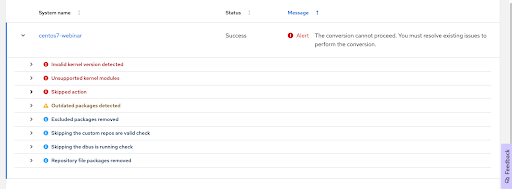
You can find all Insights tasks at Automation Toolkit > Tasks.
You can learn more about these new features and get started with:
5.2.3. Advisor
New recommendations released
Fourteen new recommendations are available:
- Separate the journal directories for better performance and recoverability of InterSystems IRIS
- Enable FreezeOnError for the integrity and recoverability of InterSystems IRIS database
- The system is unable to boot when missing systemd related components
- The insights-client BASIC authmethod will reach End-Of-Life on Feb 28th, 2024
- The /var/log/messages or /var/log/secure are not writable due to incorrect syslog configuration, file permissions or SELinux context
- The InterSystems product version is older than ideal for top-quality support
- Recommend running SystemPerformance 24-hour daily for InterSystems IRIS
- Kernel panic occurs when cifs filesystems are mounted on the RHEL 8 system due to a bug in the kernel
- Set arbiter to prevent a possible split-brain situation for InterSystems IRIS
- Map the Write Image Journaling (WIJ) disk for better performance of InterSystems IRIS
- Use G1 garbage collector to get better performance for JBoss server
- The system will boot into emergency mode when the os-release file is lost
- Applications failed to create sessions when the maximum session limit is reached
- It takes an unexpected long time for the system to boot due to a known bug in systemd
New InterSystems topic
Red Hat Insights currently has ten Advisor recommendations available for the InterSystems workload. You can find the InterSystems recommendations in a new Advisor topic at Advisor > topics > Intersystems on the Red Hat Hybrid Console. Insights will continue to add InterSystems-focused recommendations to this new topic. To see all Advisor topics, go to Advisor > topics.
5.2.4. Patch
Improved patch reporting for Satellite-managed hosts
You can now check in Satellite-managed hosts with a new –build-packagecache flag for better reporting of installable updates. With the flag set, the host will self-report the list of updates that should be installed based on the content available in the Satellite content view to which that system is subscribed. You can find more information in:
- Knowledge-Centered Service (KCS) article: Red Hat Insights shows incorrect patch reporting for Satellite-managed systems.
5.2.5. Subscriptions
Support for new Red Hat Enterprise Linux variants in Subscriptions
The subscriptions service now supports reporting for the following Red Hat Enterprise Linux variants on x86:
- Red Hat Enterprise Linux for SAP
- Red Hat Enterprise Linux Extended Update Support (EUS) Add-On
- Red Hat Enterprise Linux High Availability Add-On
- Red Hat Enterprise Linux Resilient Storage Add-On
- Red Hat Enterprise Linux Extended Life Cycle Support (ELS) Add-On (On-Demand)
5.2.6. Image Builder
Known issue: Insights image builder fails to build RHEL for Edge images when npm is included
When building RHEL 8 images within Insights image builder, you cannot customize your RHEL for Edge image with the npm package. The NPM package manager expects its configuration to be in the {prefix}/etc/npmrc directory but the npm RPM packages a symlink in the /usr/etc/npmrc directory that links to /etc/npmrc. To work around this problem, include the npm package inside of the OSTree system.
Insights image builder now supports building images for the aarch64 architecture
This enhancement to image builder extends support to the aarch64 architecture, which allows you to select the architecture that you want to build. The compatible target images that you can build for the aarch64 architecture are Amazon Web Service (AWS), Bare Metal, and Guest Images.
Support to build images suitable for Windows Subsystem Linux (WSL)
You can use the Red Hat Insights image builder to create an image suitable for Windows Subsystem Linux (WSL). You can use that image to run a Linux environment directly on your Windows machine. You can use most of the command-line tools, utilities, and applications. The kernel is supplied by Microsoft, and developed on WSL2-Linux-Kernel. This is supported only for the Red Hat Enterprise Linux (RHEL) 8 release. For more information, see Create customized RHEL images for the WSL environment.
5.3. Red Hat Insights for OpenShift
5.3.1. Advisor
Advanced Cluster Manager 2.9 fleet Insights integration
Red Hat Advanced Cluster Manager (ACM) 2.9 has introduced a new overview dashboard, and detailed views that improve navigation, when viewing critical information emitted by OpenShift Container Platform clusters. This revamped experience is similar to the one that Red Hat’s Site Reliability Engineering (SRE) team uses to manage Red Hat clusters.
5.3.2. Cost Management
Security-focused Frequently Asked Questions (FAQ) published
Red Hat Insights cost management service uses its own operator (Cost Management Metrics Operator), to gather and upload data to Red Hat. The data is then processed in its own data pipeline. As a result, there are some differences related to what data is collected, how it is processed and stored. A Frequently Asked Questions (FAQ) article about Cost Management security is available to help answer your questions regarding how the operator handles this data. You can find the FAQ at Cost Management Software as a Service [SAAS]-Security FAQ.
Support for new service account authentication
Project Koku, the upstream of Red Hat Insights cost management, released the Koku Metrics Operator version 3.1.0. This adds support for token-based service authentication, for service accounts in the Hybrid Cloud Console.
Insights expects to release the downstream Cost Management Metrics Operator version 3.1.0 with the upcoming delivery of token-based authentication on the Hybrid Cloud Console.
Chapter 6. October 2023
6.1. Red Hat Hybrid Cloud Console
6.1.1. General
Sources and Integrations UI Overhaul
To simplify the user experience and consolidate services, sources and integrations have now been combined into Integrations. You can now connect all integrations (for example, external AWS cloud integration, Slack integration, and so on) in a single place.
Notifications UI Refresh
Previously, notifications were grouped by product family. The notifications service now offers an Overview landing page as a single place to configure all events, as well as a separate page to view events.
6.2. Red Hat Insights for Red Hat Enterprise Linux
6.2.1. Published Blogs & Resources
- Blog - What’s new in Red Hat Insights cost management in Q3 2023 by Pau Garcia Quiles (October 3, 2023)
- Blog - Exploring Red Hat Insights integration with PagerDuty by Jerome Marc (October 4, 2023)
- Blog - Red Hat Insights Collection for Event-Driven Ansible by Jerome Marc (October 10, 2023)
- Blog - How Red Hat Insights tackles malware head-on by Alessandro Rossi (October 13, 2023)
- Blog - A complete view of systems vulnerabilities using Red Hat Insights by Mohit Goyal (October 24, 2023)
6.2.2. Inventory
Inventory Groups now available
The Inventory Groups feature enables you to set permissions on specific inventory objects, such as inventory groups and systems. You can organize systems inventory into different groups, as well as restrict access to specific users for each group. Once you configure user access, those system permissions take effect across all Insights services.

For more information about configuring inventory groups, refer to Viewing and managing system inventory.
6.2.3. Advisor
New recommendations added
- The performance of InterSystems IRIS server may be impacted when Transparent Huge Pages is enabled.
-
Apply
hugepagesrecommendation for better performance of InterSystems IRIS. -
Apply
shmmaxrecommendation for better performance of InterSystems IRIS. - Degraded DNS performance on RHEL 8.5 when Ethernet Controller X710 for 10GbE SFP+ with i40e driver is used.
-
The
tuneddoes not start automatically when the OS boots with graphical target mode. - System hangs due to a known kernel bug in the e1000e driver.
- Application failure occurs when the consumption of file descriptors reaches limit.
-
The
chronyservice cannot resolve NTP server’s hostnames when it does not have the read permission to the/etc/resolv.conffile. -
The
sendmailservice rejects or queues emails when the system load is high.
6.2.4. Vulnerability
Users can now view CVEs without Errata/Advisories that affect their environment
You can now view and assess CVEs that do not have associated Errata/Advisories, but which could still affect your environment. This capability allows your organization to understand its full exposure to CVEs, and to take the necessary steps to mitigate any risks.
For more information about CVEs without Errata/Advisories, refer to this blog article.
6.2.5. Malware Detection
Ability to disable/enable malware signatures
The Malware service now allows you to disable signatures that are not relevant to your environment, in order to reduce noise and to enable you to focus on important and relevant signatures.
This feature enables your organization to make better-informed decisions about where to focus efforts, as the computing footprint grows and the resources managing the infrastructure shrink.
6.3. Red Hat Insights for OpenShift
6.3.1. Advisor
Workload recommendations ready for OpenShift Shared Control Plane
The Advisor service offers recommendations that follow best practices for deploying and running managed OpenShift workloads. These recommendations check for correct limit settings, working with budgets, and implementing best practices that do not harm the underlying cluster.
The October release of the Workload recommendations feature supports Red Hat Hypershift, also known as Red Hat Shared Control Plane on AWS. With this release, the Advisor UI can now show recommendations specific to this flavor of managed OpenShift.
6.3.2. Cost Management
Tag inheritance
A common reporting practice involves tagging every (OpenShift and non-OpenShift) resource that an application uses as application=X, and then requesting a cost report based on application=X from Cost Management.
In some cases, the tags did not propagate through the entire tag hierarchy, or the tags were propagated but not exposed. One example of this issue occurred previously, when OpenShift tags were propagated to PVs and PVCs, but the tags were not available in the Cost Management API. OpenShift now propagates all tags to all levels, and exposes them in the API.
AWS external ID authentication
AWS now supports the use of a unique external ID when creating IAM roles with cross-account access, and suggests using the unique ID as a best practice. You create the role in the Cost Management AWS source flow.
Cost Management now supports external ID. When you create an IAM role, the Integrations wizard flow for Cost Management AWS generates a per-customer randomized string for the external ID in AWS. Copy and paste the string into the External ID field.
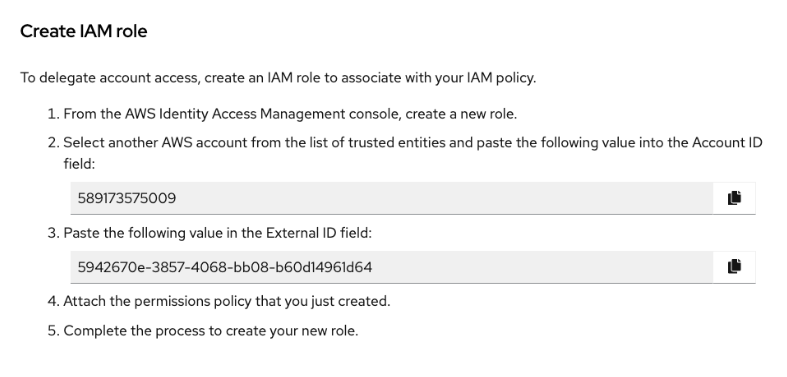
When a source is created, Sources (Integrations) passes along the external ID and the Amazon Resource Name (ARN) role in a message to Cost Management.
Automatic OpenShift source name
To get per-cluster, per-namespace, and per-tag costs in an OpenShift cluster, install the Cost Management Metrics Operator (CMMO) and configure it to submit data to Red Hat.
The CMMO YAML file contains the Source (integration) name, which identifies the cluster in Cost Management. Previously, configuring the operator instance included manually changing the value of name from the default INSERT-SOURCE-NAME to a custom value. Not changing the value of name from the default value caused confusion, as well as difficult debugging issues.
OpenShift Container Platform (OCP) now automatically generates the OpenShift Source name. if you manually set a Source name, the CMMO uses that name; if not, CMMO automatically generates a Source name based on the clusterID.
You can manually change the auto-generated name.
To disable automatic Source name creation, change the create_source parameter value in the CMMO YAML file to false.
create_source: false
name: INSERT-SOURCE-NAMEChapter 7. September 2023
7.1. Red Hat Hybrid Cloud Console
7.1.1. Published Blogs & Resources
- Blog: Deploy containerized applications with Red Hat Insights Edge Management and Podman by Matthew Yee (September 12, 2023)
- Blog: Managing SAP servers with Red Hat Insights by Ricardo Garcia Cavero (September 15, 2023)
- Video: Event-Driven Ansible using Red Hat Insights by Nuno Martins (September 15, 2023)
- Blog: Remote host configuration and management for Red Hat Enterprise Linux by Joerg Kastning (September 20, 2023)
- Blog: Build and launch Red Hat Enterprise Linux images in Oracle Cloud Infrastructure by Terry Bowling (September 21, 2023)
- Video: Red Hat Insights integration with Splunk by Jerome Marc (September 25, 2023)
- Video: Red Hat Insights integration with Event-Driven Ansible by Jerome Marc (September 26, 2023)
7.1.2. Notifications
Daily email notification time can now be configured per account
The time at which daily email notifications are sent out every day is now configurable under Hybrid Cloud Console > the Settings icon (⚙) > Settings > Notifications for OpenShift, Red Hat Enterprise Linux, and Console. A new Settings tab allows each account to override the default 00:00 UTC time with the time of their choice. This enhancement was implemented based on feedback received from EMEA customers wishing to receive their daily notifications every morning before they start work.
User Preferences are consolidated for centralized configuration
All settings related to email notifications are now consolidated under Hybrid Cloud Console > User Preferences > Email Preferences. Weekly report configuration and event notifications (e.g. instant and daily digest) can all be configured in the same location. This enhancement was implemented based on feedback received from customers for ease of use.
7.2. Red Hat Insights for Red Hat Enterprise Linux
7.2.1. Advisor
New Recommendations
- Kernel panic will occur when the qxl driver is being used on the RHEL 8 system after reboot due to a bug in the default kernel
- Apply swappiness recommendation for better performance of InterSystems IRIS
- Squid service listening on IPv6 gives slow access to its client even when ipv6 is disabled in sysctl
- The system is unable to boot when missing glibc related components
- Kernel panic occurs when AMD processors with IOMMU enabled are used due to a known kernel bug
- Kdump fails to dump over NFS or SSH on a virtual machine when FIPS is enabled due to a known bug in kexec-tools
- VMware guest performance decreases and shows as vulnerable to RETBleed due to a known kernel bug
- The CUPS print requests are rejected when the "MaxJobs" limits have been reached
- Some applications will show errors or fail when they are not able to write to /tmp with the appropriate permissions
- Kernel panic will occur on heavy memory fragmentation system when ib_port module is loaded due to a known kernel bug
- LVM commands that change the Volume Group configuration will fail to run when the LVM metadata area is not big enough
7.3. Red Hat Insights for OpenShift
7.3.1. Advisor
Deployment Validation Operator (DVO) to be released on Red Hat OpenShift for AWS (ROSA) hosted control planes (hypershift)
DVO, serving Insights workload analysis, is now available on managed clusters and is ready to be shipped with ROSA Hosted Control planes alongside OpenShift 4.14.
Customers will also benefit from seeing user-friendly namespace names/project names instead of UIDs. This will allow customers to easily recognize and navigate to projects that need their attention. All recommendations are of course coming with actionable steps on how to prevent or resolve detected issues.
Deployment Validation Operator data de-anonymization
On our route to better user experience, DVO for on-premise customers allows opting-in for a non-anonymized form of data collection. This reduces the number of steps required to apply fixes suggested by a recommendation.
Chapter 8. August 2023
8.1. Red Hat Hybrid Cloud Console
8.1.1. Published Blogs and Resources
- Blog - Red Hat Insights Compliance: Introducing new customization options for policies Mohit Goyal and Marley Stipich (August 2, 2023)
- Blog - Stay on top of systemd state with Red Hat Insights by Stefan Bunciak (August 2, 2023)
- Blog - Improve your cloud cost visibility with Red Hat Insights cost management feature by Chris Hambridge (August 22, 2023)
- Blog - Red Hat subscription management: Simple Content Access (SCA) explained by Zach Connor (August 25, 2023)
- Blog - New Red Hat Insights capabilities available for managing Red Hat Enterprise Linux by Keri Sprinkle (August 28, 2023)
Blog - Livestream Recordings - Modernizing RHEL Management Mini-series
- Episode 2: Build and Launch by Eric Hendricks and John Spinks (August 1, 2023)
- Episode 3: Simplifying Patch Management by Eric Hendricks and John Spinks (August 8, 2023)
- Episode 4: Three Services to Operationalize RHEL by Eric Hendricks and John Spinks (August 15, 2023)
- Episode 5: Protecting your systems by Eric Hendricks and John Spinks (August 22, 2023)
- Episode 6: Regulatory Compliance by Nate Lager and John Spinks (August 29, 2023)
8.1.2. General
New RHEL management capabilities are GA
At Red Hat Summit, you heard the announcement about the expansion of Insights beyond analytics. Red Hat designed the new and enhanced management capabilities to help reduce enterprise Linux complexity across the hybrid cloud without slowing innovation. With this release, all the Insights features and enhancements announced at Red Hat Summit are generally available (GA).
Additional resources
- Blog - New Red Hat Insights capabilities available for managing Red Hat Enterprise Linux Describes how Red Hat Insights capabilities work with the ongoing journey to enable better end-to-end RHEL management.
8.2. Red Hat Insights for Red Hat Enterprise Linux
8.2.1. Advisor
Export recommendations for a single system
You can now export a list of recommendations for a single system to either CSV or JSON. This provides an easy way to create a to-do list if you have not adopted a more automated means of addressing found issues.
Several new recommendations are available
- XFS writes are limited by quota when warn counter exceeds the upper limit
- Performance issue occurs when the "num_cgroups" for blkio in cgroups keeps increasing due to a known bug in the kernel on RHEL 8.6 and 8.8
- System hang occurs when audit backlog limit is exceeded on RHEL 8
- The yum command fails when the release version cannot be detected
- The sshd sessions will be very slow when the available entropy is low on virtual machines *The setroubleshootd process is consuming high memory due to a known bug in setroubleshoot-server
- The system is unable to boot when lvm2 package is missing
- The change of team interface MACADDR makes network packages with old MACADDR sent to it dropped due to a bug in NetworkManager
8.2.2. Drift and Policies
New systemd facts available for Drift and Policies
When setting up baselines and comparisons for system drift, or creating internal system policies, now you can access a set of systemd facts. These facts include systemd.failed, systemd.jobs_queued, and `systemd.state.
8.2.3. Image Builder
Now Generally Available (GA)!
With the latest Insights Image Builder, you can add third-party Red Hat Package Manager (RPM) repositories to include third-party software and deploy hosts to the cloud easily by launching custom image builds directly to AWS, Azure, and Google Cloud.
8.3. Red Hat Insights for OpenShift
8.3.1. Advisor
Update Risk - Generally Available (GA)
Update Risk is now available in the Red Hat Hybrid Cloud Console for all OpenShift customers as part of your OpenShift subscription. Update Risk (previously available in the preview environment as “Upgrade risk”), allows customers with self-managed OpenShift clusters to assess the state of your clusters before running updates. A machine model trained on data from all connected clusters shows a list of known risks on your cluster. This includes failing operator conditions, alerts, and other metrics. Insights provides you with instructions on removing these blockers on your path to a smoother and safer update.
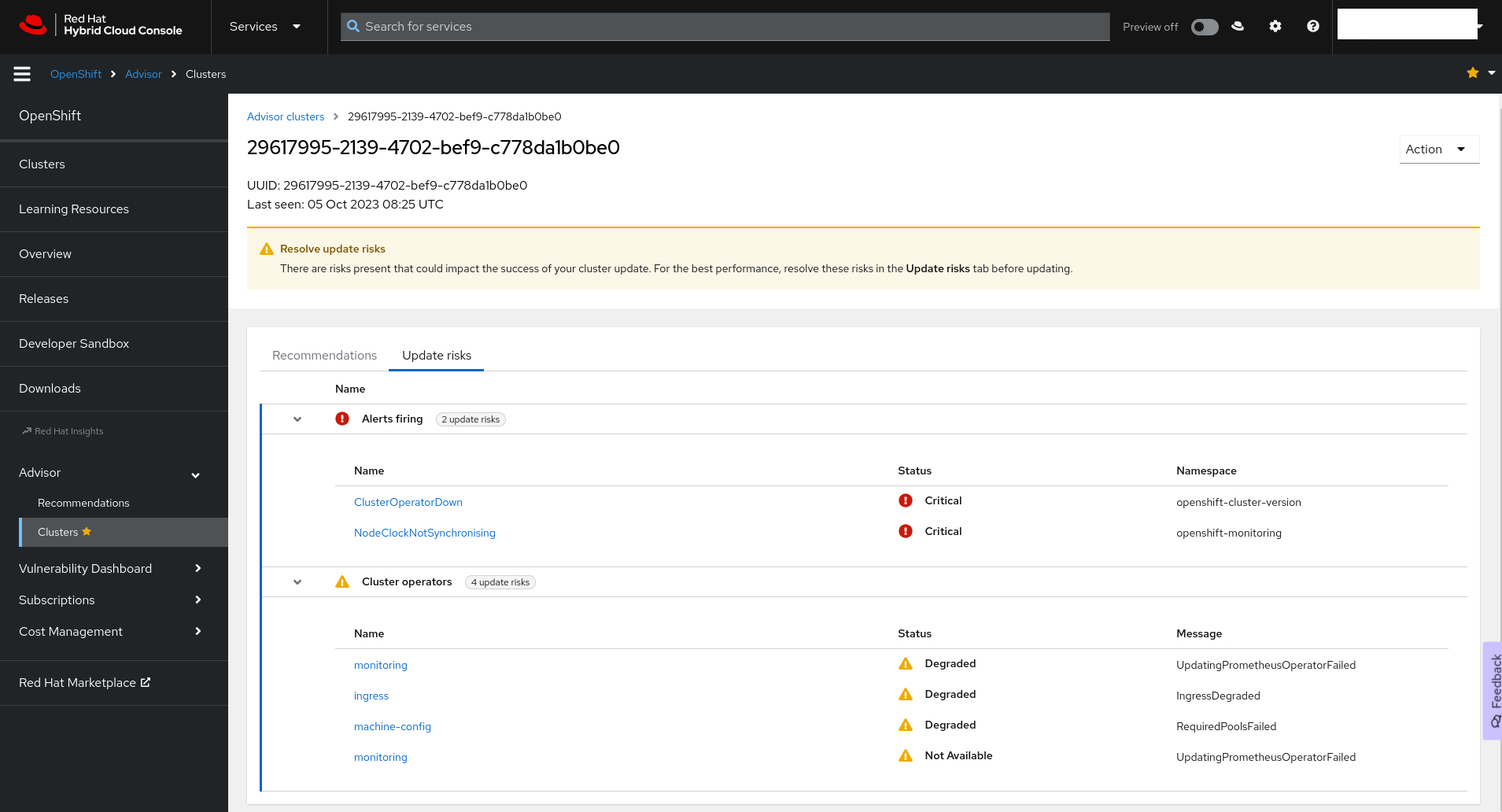
Additional information
8.3.2. Cost Management
Report vCPU count, RAM, and storage capacity
By default, Cost Management distributes costs based on effective CPU usage. When an OpenShift cost model is added, you can change this to distributing based on requested, used, or effective CPU or RAM usage, for the costs that Cost Management is aware of.
IT workloads and departments always incur additional costs: subscriptions, external services with variable costs (e.g., Google Maps), outsourcing, cost of the IT employees, etc. Different customers adopt different policies to distribute these costs. One popular way of distributing costs is to “do the same thing Cost Management does for OpenShift workloads,” which requires knowing how many CPU cores and memory the OpenShift nodes and clusters had and used so that those numbers can be extended for other costs.
You could approximate these values by dividing the CPU core-hours and RAM GB-hours and dividing by the number of hours in the month, but if using autoscalers, those numbers would not be right. Insights now reports the number of CPU cores and RAM and informs users this is the maximum value, since autoscalers might have changed the capacity at any given time.
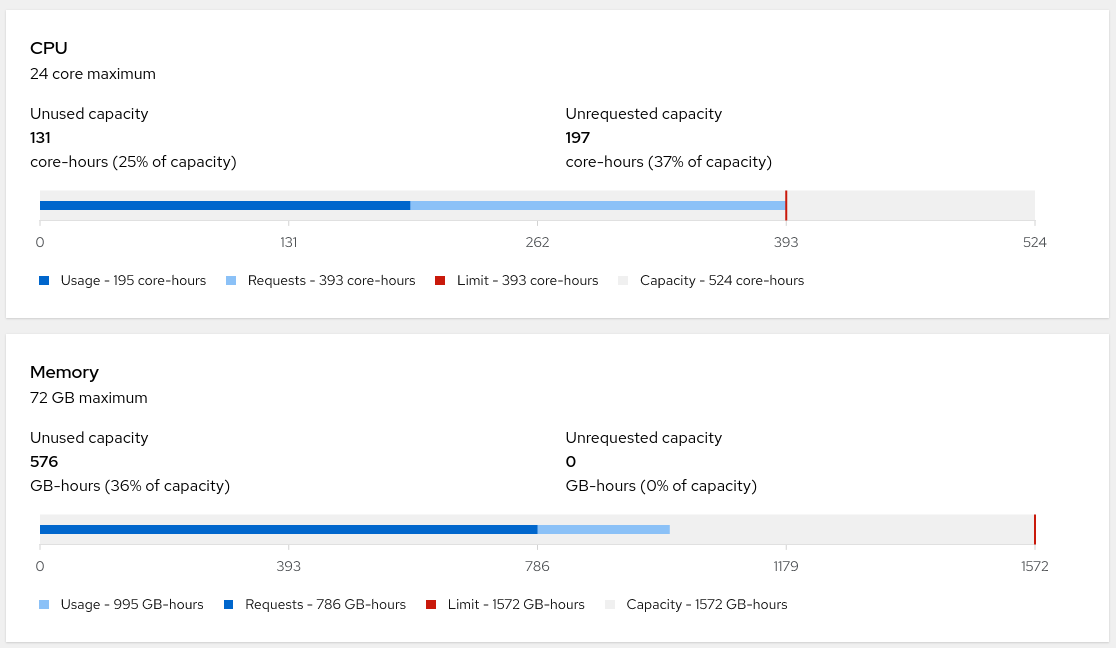
Settings page: redesigned and moved
The Settings page is now inside Cost Management for easier discoverability. The Tag Management and Cost Categories subpages also have enhancements. The cost models page is now inside the Settings page too. While moving the Settings page inside Cost Management, Insights also relaxed the permissions so only Cost Price List Administrator permissions are now needed. In the past, modifying the Cost Management Settings required Hybrid Cloud Console-wide Organization Administrator permissions, which made some customers uncomfortable because tag managers had too much control and visibility.
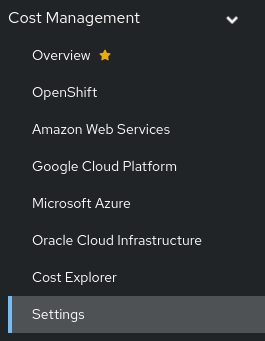
Option to show overhead costs
When running your workloads on OpenShift, you are likely interested in the cost of the workload, but you also need to consider the cost of the control plane and the cost of the unallocated capacity (the “overhead costs”). Insights Cost Management enhanced cost models and is now reporting those costs as of early 2023. With this update, you can distribute the costs, and also dynamically switch to viewing costs with or without overhead cost distribution.
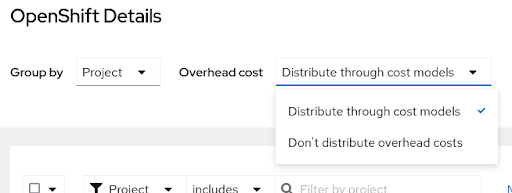
Large customer data pipeline
Many organizations that use Insights Cost Management are big customers, but no matter your infrastructure size, Insights can handle your needs.
The latest release of Insights Cost Management implements separate pipelines for different customer sizes so that Cost Management processes data from all customers and is responsible, even if some large customers decide to send data for a whole month for a thousand clusters at the same time.
Additional resources
Blog: What’s new in Red Hat Insights Cost Management in Q3 2023 by Pau Garcia Quiles (October 3, 2023)
Providing feedback on Red Hat documentation
We appreciate and prioritize your feedback regarding our documentation. Provide as much detail as possible, so that your request can be quickly addressed.
Prerequisites
- You are logged in to the Red Hat Customer Portal.
Procedure
To provide feedback, perform the following steps:
- Click the following link: Create Issue
- Describe the issue or enhancement in the Summary text box.
- Provide details about the issue or requested enhancement in the Description text box.
- Type your name in the Reporter text box.
- Click the Create button.
This action creates a documentation ticket and routes it to the appropriate documentation team. Thank you for taking the time to provide feedback.

